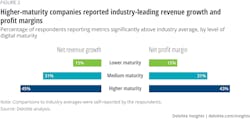Latest from Best Practices
The 2025 Tax Season is Upon Us! Are You Ready?
All About Indoor Air Quality, Part 3
Sponsored
By Shanthi Rajan, CEO/Founder, Linarc
The past decade has seen a constant and much-anticipated surge in how modern technology has entered the day-to-day of businesses across every industry. In the construction sector, conventional operations have received a complete overhaul owing to advanced tech, practically impacting all aspects of the construction value chain.
Equipment tracking, robotic total stations, ground-penetrating radar (GPR), Light Detection and Ranging (LiDAR), Global Positioning Systems (GPS), Building Information Modeling (BIM), Laser guidance, drones, and robotics, machine vision, object and person detection, and advanced sensors to track infrastructure wear and tear are some of the key technologies that are transforming the construction industry.
Managing budgets to optimizing workforce schedules, the impact is significant and highly welcomed by the heavy civil and infrastructure contractors. This transformation is not superficial and merely bettering the operations but is creating measurable impacts in site safety, workforce productivity, and ultimately the profits brought in—literally a win-win.
While the proliferation of technology used by contractors and field workers has helped make a tremendous shift in making the construction industry operate like never before (low to no onsite injuries, higher accuracy, faster time-to-market), the adoption isn’t comprehensive (yet). And there are often missing parts that make the puzzle incomplete.
Defining Digital Maturity
One of the key elements that make technology so desirable is the convenience of connecting field workers with the office. When the collaboration is real-time, the field workforce is more equipped with the latest business resources. Managers can assign tasks, analyze employee performance and optimize processes to improve the overall site efficiency. By integrating the field systems with business processes end-to-end, contractor profits can soar and the overall revenue follows through.
And this is what it means to be digitally mature, viz-a-viz the construction industry. Digital maturity helps organizations truly unleash the benefits of digital transformation. It helps employees thrive and this reflects in the culture, profitability, and overall performance of the organization.
And while most organizations in the construction industry agree with the benefits of digital adoption, getting ahead of the curve with digital maturity is the real challenge. And more often than not, organizations struggle with getting started.
Assessing Your Current Digital Maturity Level
To begin with, knowing where your organization stands with digital maturity is important.
Just like you would survey the existing conditions of the site before embarking on a construction project, you need to assess where your organization is currently in the four levels of digital maturity.
Digital Novice
As a digital beginner, your organization has partial digital capability. Your processes are predominantly manual, and you use some digital tools that may not be fully integrated into your workflows. Your digital adoption lacks a cohesive strategy, resulting in inconsistent communication between the office and onsite teams. Your teams typically use multiple channels such as calls, text messages, and field photos to communicate. As a result, managers are frequently required to make decisions without sufficient context-aware information.
Digital Journeyman
At the journeyman level, your organization integrates digital tools and processes with a basic strategy, but it lacks a fully-funded digitalization program. Although the organization understands the benefits of having real-time data, the team is not yet equipped to use it. The digital efforts are ad hoc and on an as-needed basis, typically when the project owners demand it. The daily office workflows begin to adopt technology-enabled workflows, but field adoption lags behind.
Digital Senior
If you are in this stage of digital maturity, it is safe to say that your company has a long-term strategy, not to mention advanced digital capabilities that drive real-time data reporting, and your CXOs (Chief Experience Officers) have a bird's eye view into your operations. Being a Digital Senior can aid in capitalizing on opportunities created by digital transformation to the fullest.
Digital Citizen
As the name suggests, Digital Citizen is the ultimate level of digital maturity. If your organization leverages the entire suite of the digital ecosystem, including tools and processes for a strategic benefit, it is safe to call it a Digital Senior. This includes having subject matter experts on your team that can guide the way for project owners and developers with expertise in Artificial Intelligence (AI), Machine Learning (ML), AR/VR, IoT, and automation, along with predictive analytics.
From One Level to the Next
With technology, change is really the only constant. All said and done, Digital Seniors also have to constantly evolve and keep up with the upcoming trends in technology for their advantage. With the ever-expanding interest and investment in construction tech, digital maturity needs to be a continuous effort (if it already isn’t one).
Here’s how you can keep up:
- Know your vision, your roadmap, and your milestones
After you know where you are in the digital maturity processes, know where you want to go next. This cannot be night and day from your company’s goals and should be achievable, aligning with your roadmap. Hence, you should not only have a vision but a solid roadmap in place, along with milestones that will help you track your progress. This could mean something as simple as location tracking for your equipment or adopting a cloud-based construction management software to streamline your operations- it doesn't have to be all or nothing!
- Know your budget
Anything and everything that you set as your goal needs to be budgeted. The simple integrations will be able to generate ROI faster—for example, an automated/ digital timesheet instead of traditional punch cards for clocking time—than the more complex integrations that can be implemented in phases.
- Drive cultural change
The prime drivers of digital adoption are your employees and having them onboard is critical. You want to help your employees hop on the change wagon by equipping them with the right resources (including strong thought leadership that can help them understand the importance of the changes happening) and a change management plan to accommodate the changes in phases.
- Work with a schedule
You can’t expect digital transformation and digital maturity to work in your favor without having a well-chalked-out schedule. To make the process well-oiled, it’s best to opt for a project management system that can help in creating an end-state roadmap, add small clusters of tasks and achievements that you want to track (with relevant data points) and also measure the overall ROI, with little to no manual effort.
- Don’t forget the small wins
Often as a decision-maker for an organization, you might not be able to celebrate your small wins in the journey toward digital maturity. And while it makes sense always to have the bigger picture in mind, it’s also important to celebrate successes achieved as you embark on the journey. It could be something as simple as improved efficiency due to real-time knowledge sharing or money saved by advanced budgeting and optimized scheduling. Every penny does really count, and it can help you and your workforce to look forward to bigger, more complex implementations.
The complete digital transformation of the construction industry is inevitable. It's not really the question of why, but how and how fast for the companies to get started on their journey to reach digital maturity.
By staying current with emerging technologies and adapting the vision and roadmap as needed, digital maturity will be achievable for any organization willing to make the commitment.
The strategies outlined for reaching digital maturity in the construction industry offer a promising path toward lasting success. By embracing new technologies, fostering collaboration and communication, and investing in employee training and development, construction companies can unlock significant gains in productivity, efficiency, and profitability. The earlier, the better.
References
https://www.cbinsights.com/research/construction-tech/
Shanthi Rajan is a seasoned entrepreneur, CEO, and founder of Linarc, a collaborative construction management solution focused on revolutionizing the antiquated construction industry. With a strong focus on enterprise applications, Shanthi brings extensive experience in all aspects of company building, including ideation, product development, product-market fit, product strategy, team building, and go-to-market strategies. As a product leader, Shanthi is committed to delivering innovative solutions that streamline construction management operations and enhance project outcomes.



